
誰が野菜の棚の下に隠れているのかな。黒板もいいと思います。
Chalkboard is a nice way to display.
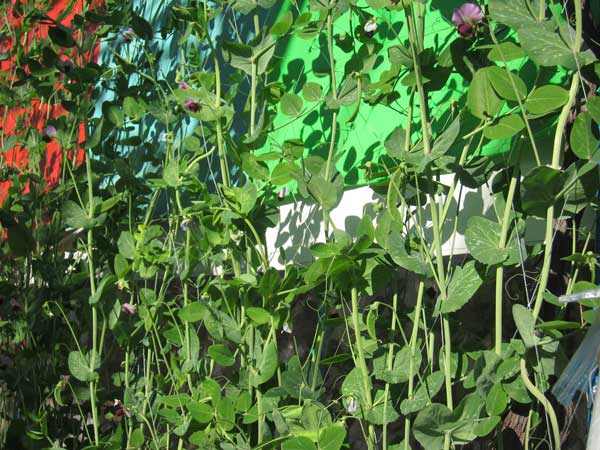
足立区で、物置小屋の隣に元気なスナックエンドウを見つけました。ベランダで私も冬に育てているけれど、こんなに元気じゃありません。うらやましいです。
These snap peas look very vigorous growing alongside a large tool shed in Adachi-ku in December. While visiting the cherry trees of this northeastern section of Tokyo, I was delighted to see these fantastic vines inside a work space visible next to the sidewalk. Last year I learned that you can grow this vegetable in Tokyo’s winter. I wish mine looked so full and so ready to provide many meals.

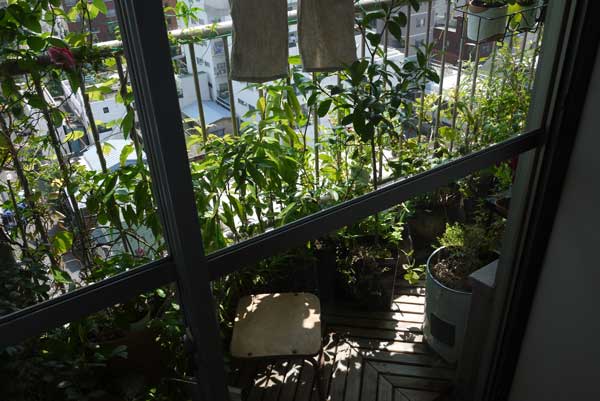
晩夏のベランダの庭は混沌としています。いろいろな多年草と一年生植物、花と野菜でいっぱいです。夏草と常緑草で出来ているグリーンカーテンで、アパートの中を涼しくしています。この長くて狭いバルコニーのスペースにはエアコンと洗濯機と物干しロープもあります。
The balcony garden in late summer is chaotic. A variety of perennials and annuals, flowers and vegetables, seasonal and year-round plants form a green curtain that provides some shade and cooling for the apartment. The long and narrow space also includes the air conditioner, washing machine, and clothes line.
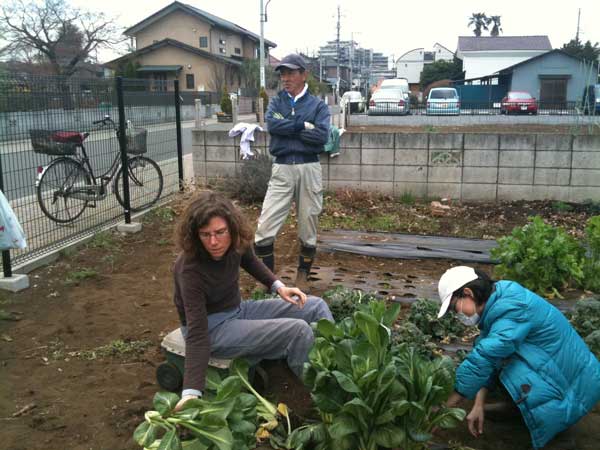
友達のジョアンは西東京の駅の近くで畑を作っています。ジョアンに野菜をたくさんもらいました。夏のポテトサラダに使うために、ベルガモットもくれました。
Fifteen minutes on the express train and four blocks from the station, my friend Joan is farming a small plot of land. It’s actually several short rows that form part of a much larger city farm owned and operated by a Japanese retiree. As soon as I saw him, I was glad that I, too, had prepared for weeding and harvesting by wearing the all important white work towel.
Joan blogs and writes about urban farming, farmers’ markets, city landscapes, and Japan travel. It was very exciting to actually see Joan at her farm. I was impressed that she had also recruited a neighbor and her husband’s co-worker to help with tidying up the winter beds, getting ready for planting, and harvesting and taking home the last winter vegetables. There was a huge leafy bounty that Joan shared with us: Russian kale, red karashina, brocoli, spinach, komatsuna, and shungiku. Joan also sent me home with some bergamot that I am growing on my balcony. I am still waiting for Joan’s famous bergamot potato salad recipe. And I was able to share what Joan gave me with three other households.
We all gathered at the farm just two weeks after the Tohoku quake, tsunami and nuclear crisis. It was great to be outdoors, talking about city vegetables, chatting with friends and new acquaintances. I liked hearing about Joan’s permaculture ideas of doing less, leaving flowers to attract pollinators, and hand mowing rather than eliminating the weeds between rows. The Japanese man who owns the farm clearly has a different attitude since he keeps his farm empty of all plant life except for the vegetables he grows. I can sense that Joan and the farmer each want to show the other how to farm. There’s both conflict and mutual respect for each’s passion for city farming.
I hope to go back as often as I am invited.

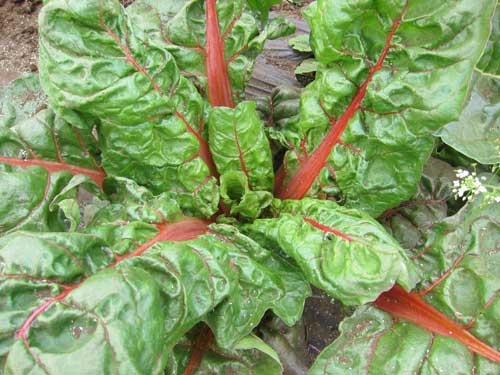




屋上と壁の庭はきれいなんです。
Recently, Mukunoki Ayumi gave me a tour of Kuboco, the construction and roof garden company where she works in Shitamachi. She graduated from Nodai, where I am a research fellow. The meeting took place thanks to Edgy Japan‘s Yanigasawa Hiroki. I immediately recognized the building when I spotted the incredible wisteria that is trellised across one building and climbs to the top of the adjoining 8 story building, where it provides rooftop shade on a trellis structure. Mukunoki-san told me that the vine is just eight years old and very vigorous!
Kuboco designs roof gardens and vertical gardens for commercial and retail buildings as well as residences. Since they are a construction company, they are able to combine garden design and maintenance with structural engineering, water-proofing, and retrofitting trellises for vines and vertical gardens onto older buildings.
Mukunoki-san reports seeing a shift from roof lawns to vegetables in Tokyo. She attributes this to customers wanting less maintenance and greater value from their outdoor spaces. Kabuco has roof gardens on both of its buildings, one a more social space and the other full of experiments with soil depth and new vegetables. Kuboco is very hands-on in providing advice about how to build roof gardens and what to grow. Mukunoki-san explained that last summer she grew tumeric because one of her clients wanted to grow it. On my visit, I saw blueberries, carrots, onions, parsley and other food on their demonstration gardens, and admired how they are testing out what can grow in 5, 10, 20, and 25 cm deep soil boxes. And for a while Kuboco’s roof garden provides fresh vegetables to a local onigiri restaurant.
She also introduced me to the Japanese term for “local food”: 地産地消 (chisanchishou, locally produced and locally consumed, with the first and third kanji being the word soil).


The 8 year old wisteria looks like it’s been on this building for much longer. It blooms best when trained horizontally.

I would love to try blueberries, too. It would be so satisfying to eat fresh blueberries, rather than the supermarket ones that have travelled from as far as Chile.


Free Farmの野菜をリゾットにしました。友達にもすすめます。http://freefarm.co.jp/ @TEDxSeeds で、Twitter の @FREEFARM_taro に会いました。
Free Farm vegetables made into risotto! Check out http://freefarm.co.jp/, which I learned about via @TEDxSeeds.
I learned about Free Farm, a farm-to-city vegetable service, at this year’s TEDxSeeds conference. Recently we received a box of incredibly fresh, organic vegetables that put our normal supermarket food to shame. The carrots tasted sweet, the shiitake were grown on trees and not artificial “medium,” the baby daikon were gorgeous and full of flavor. There was also a small Chinese cabbage and a mild leaf vegetable we had never heard of called okanori (おかのり), which means land seaweed. (Apparently, when dried, it smells or tastes like seaweed).

The vegetables came in a simple box and were wrapped in the Financial Times newspaper. Also included were the names of the vegetables, information about the farm in Tochigi, some ideas for how to eat the vegetables, and a hand-written note from the farmer. The box including the vegetables above cost 2,000 yen, or just over 3,000 yen with the costs of shipping and “furikomi.” I highly recommend this food service, and you will enjoy it even more if you can read Japanese. A similar French service in Tokyo is Le Panier de Piu.
Here’s the risotto we made from the okanori, shiitake, and baby daikon.

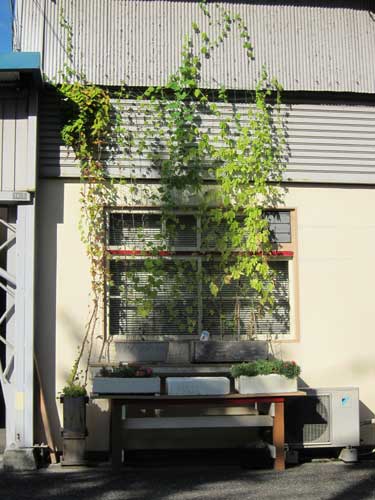
This small green curtain makes a nice contrast with Suginami’s giant green curtain. When I see small green curtains, mostly they are on residential balconies and small houses. This one is at a car shop across the street from a printing factory in Bunkyo ward. I love how the shop worker or manager chose to create a small green spot with bitter melons climbing up the window and to the roof. It’s great to see people make use of work time and space for some vegetable gardening.

This is the second okra plant I have spotted along the small street leading from my apartment to the JR station. I was impressed with how beautiful its flower is. In the background is a climbing bitter melon vine, and a dog house. The “yard” is paved, so all the plants are in pots.

I have been passing this pot of okra for a weeks as I walk to the station. It’s great that this small pot is at eye level. A few days after I took these photos, they were harvested. I wonder how the neighbor cooked them.
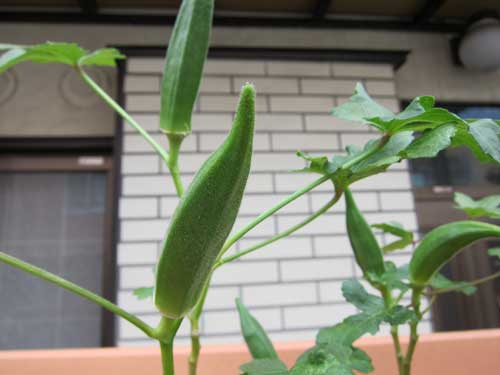
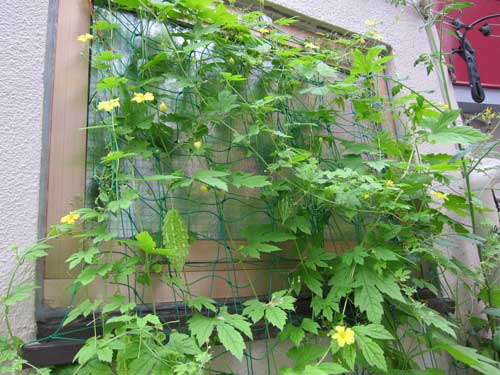
A Sendagaya gardener is growing bitter melon on a mesh net for summer. You can see the prickly green vegetables (tastes great with ground pork). In the context photo, you can see how easy it is to grow in a small size pot on the sidewalk. I like how it covers the window, and dwarfs in size the vending machine.


3331 Arts Chiyoda is a cool art space recently created by the Chiyoda ward government. They converted an old junior high school into exhibition galleries, art studios, and creative industry offices. In addition to a beautiful remodel of the unused school building, the ward also refurbished a small park at the entrance.

Katsuhiko Hibino created this created this beautiful morning glory green curtain rising on the front side of 3331 Arts Chiyoda. Called the Asatte Asago project, the morning glory seeds here had been taken to space by Japanese astronaut Naoko Yamasaki. The project involves community gardening and sharing across different regions of Japan.
Other green projects at 3331 Arts Chiyoda include Chaco Kato’s”Slow Wheat” project at the cafe, with wheat grass plants that will be used as a health drink. The art space is also offering small vegetable plots on the school’s rooftop. If you live nearby, check it out!
On August 21, 2010, Chris Berthelsen of Fixes and I will lead a bilingual interactive workshop on greening the city from 7 to 9 pm. More details will appear soon. The same day, Kato-san will be teaching a beginner’s compost class in the late afternoon.

I recently started a blog category called “Flowers and Buildings,” which focuses on the pleasure of experiencing plants in urban settings. I think that both the plants and the buildings are more beautiful when juxtaposed together. This post focuses on my balcony vegetable’s flowers, set against the parking lot below and the cityscape beyond.

The vegetables are from top to bottom: cucumber, eggplant, and watermelon. I will soon start tying the climbers to the balcony railing so that they become part of my summer green curtain. The single bonsai watermelon I saw last year in Ginza makes me hope that maybe I can eat one home-grown one this summer.
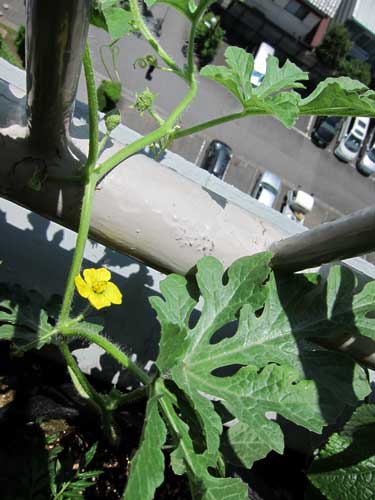

UPDATE: I posted a revised article, “Sensing Four Seasons at a Tokyo Office Building,” on Huffington Post on July 30, 2010.
Some friends and I visited Pasona’s new office last week. They are a large Japanese staffing farm that had a highly publicized basement farm in their old Otemachi headquarters. This year they moved nearby to Yaesu in their own newly built, nine story headquarters between Tokyo Station and Nihonbashi. Pasona has unveiled a much more elaborately landscaped interior and exterior.
The image above is my favorite because it highlights the interface between the futuristic farm, dependent on a variety of grow lights including LEDs, and the urban environment outside. I am certain that the indoor vegetables will give them the most attention again, but actually I believe the exterior landscaping is more inspiring and impactful.

Below is a brief tour of interior and exterior. After the photo tour, I will suggest some metrics for judging the success of this very visible corporate monument to urban nature.
Glowing all the way across the wide downtown street even in daylight, a spectacular rice paddy with dozens of strong lights occupies the main lobby entrance of the building. The entrance doors are flanked on the outside by beautiful apple trees in giant rusted steel planters.

Almost the entire first floor of the building is devoted to the spectacle of vegetables planting, growing, and ripening under powerful grow lights: rice, tomatoes, melons, corn, eggplants, herbs, and lettuce. A large cafe features wood posts hung at angles and supporting canvas bags with soil and corn. One wall has a series of metal cases with purple lights and tiny fans that have a very “next century” feel.
There is also a room with racks and racks of lettuce, and a field of giant sunflowers. And everywhere vegetables and seedlings are arranged in attractive vignettes. Elsewhere, tomatos hang from the cut-outs in the ceiling. (Click to enlarge the photos below).




What I think works are the following:
But I also have to point out where the vision falls short.
While the indoor farm will generate the most attention for Pasona, I think that the exterior landscaping is more impressive and ultimately more interesting for urban habitat creation and the integration of nature with work space. Two thirds of the building front and at least one side have been carefully planted on handsome screened balconies to produce four seasons of color. Included are citrus trees, wisteria vines, Japanese maple, blueberries, and flowering vines like clematis. Although the plants are small now, it is easy to imagine the exterior becoming a unique vertical forest and colorful garden over the next years.
The exterior vertical landscaping has 200 species of plants, and many trees that lose their leaves in the winter. The idea is that the plant mass will reduce carbon emissions, summer shade will keep the building cooler, and winter bare branches will allow more direct light during the cold season. While the public is not invited to the upper floors, it appears that the exterior plants are all on balconies that are either accessible or viewable from inside the offices. Click below to see posters that explain the exterior landscape and the designers who worked on this project, and how the exterior garden appears from the sidewalk below.



I am looking forward to watching the exterior of the building grow into its potential. And I am eager to hear how the office workers feel about the outdoor plants that are so close to their interior work spaces.
I’ll end this post with a dandelion weed I spotted on the edge of the rice field. It is this type of unplanned feature that makes natural landscapes so enchanting.
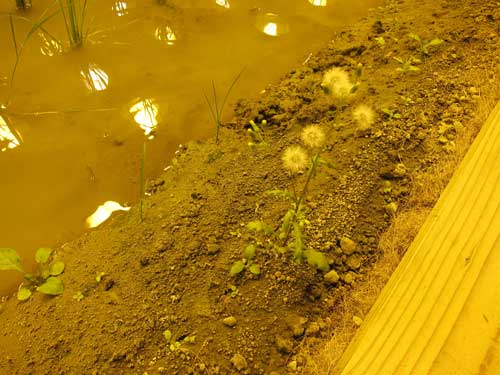

My friend and fellow anthropologist John McCreery of Word Works told me about a project created by technology corporation NEC called Big Globe. The idea is that Tokyo residents who are interested in farming can participate in planting a small plot in suburban Saitama, and then watch via webcam as their vegetables grow with the aid of a caretaker. They are invited to visit during the growing season and at harvest, but have no responsibility to take care of the plants themselves.
I wonder if the webcam truly connects city people with farming. Big Globe seems like a mixed reality in-between the virtual Farmville, wildly popular on Facebook, and actually growing plants. I realize that many people in the city do not have much land, but as I have documented on this blog, it doesn’t take much space to grow a single plant or even hundreds.
Has anyone tried out Big Globe, or heard about it before? What do you think the role of technology can be in connecting city people with farming and nature more generally?


I visited Odakyu’s Agris Seijo rental farm in Seijogakuenmae in Setagaya and was prepared to be charmed by a community vegetable farm built by a rail company above their tracks. Three years ago, the Odakyu corporation rebuilt the station, undergrounded the railway, and used some of the new land to promote urban farming. But I left feeling somewhat strange that reclaimed land could be gated and restricted. Although it is the rail company’s property, I think they missed a huge opportunity to create a great space for the neighborhood.

The farm is entered through a two story building that has a plant store on the first floor, spilling into the sidewalk, and a club room on the second floor. On entering the building, I learned that the garden was gated, and that no photographs were allowed. With my Tokyo University of Agriculture business card, I was handed a visitor’s pass. Two explanations were given about the no photography policy: customers would be concerned about their privacy, and photographers might misrepresent the photos they take. Please note that all the photos in this post were all taken from public roadways outside the gates.

Once inside, I discovered that this Agris Seijo has 303 rental plots, ranging in price between 5,500 and 14,500 yen per month ($60 to $175) depending on size and sunlight. 70% of the plots are being used, and the farm is organized in two seasons, with a fallow period during winter. Many of the customers are first time vegetable growers, and there are classes and staff to help them.
Some of what I observed: an elderly man harvesting giant sweet potatoes. Attractive netting with metallic strips to deter birds and insects. Some very attractive plots with broccoli, rainbow chard, carrots, celery, lettuce, salty leaf, peppers, basil, cauliflower, onion, eggplant, daikon radish.
Clearly burying the tracks below grade reduces railway noise for the neighbors and adds soil and plants which benefits the environment. There are benefits for customers and neighbors. Yet, I was struck by how empty the farm was during my weekday visit, and wondered why only 70% of the plots are rented after three years of operation. I also wonder if the customers or the railway company owner feels more special or important because of the gated aspect of the garden. In a city that is remarkably safe, I cannot imagine why there is a real need for keeping people out.
This wealthy project reminds me of the community garden I observed in Tsukushima. There, neighbors invested great time and effort in making beautiful spaces on an existing concrete river embankment. It appears that each gardener is expressing their own passions and perhaps competing with their neighbors. At no cost to the local government, neighbors have beautified dead space which can now be enjoyed by anyone. The Tsukushima community garden is completely accessible 24/7 and shows how ordinary people can create a great public space.
Some more thoughts and image about Odakyu after the jump.